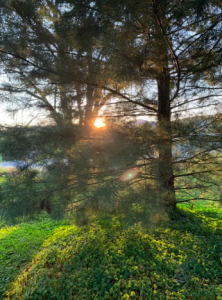
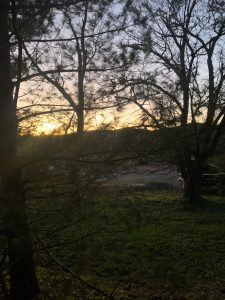
My sit-spot location at the beginning My sit-spot location at the end of the semester
of the semester covered in rich green with few pine needles remaining and lighter
pine needles and pinecones. colored plants.
The habitat and environment of my sit-spot has changed tremendously over the course of the semester. Within just a few months, the bright warming summer sun peaked through the bright green pine trees, illuminating the luscious green plants and grass, was now the same sun within the cooler temperatures peeking through the sparse pines on the pine trees, as the ground was covered in old brown pines. The immense sounds and activity present compared to the beginning of the semester, revealed that some of the animals and insects had adaptive traits and were only present during specific times of the year, and less active near the colder temperatures, later in the semester. The brightly lit sky with the few clouds within the sky allowed for the colorful and vibrant atmosphere to feel more comforting and peaceful, as the noises of the overpass highway in the distance was heard minutely. Near the end of the semester, the insects and animals were mostly quiet during the same time and the overpass highway was heard much louder. The light of the sun reaching down and completely encapsulating the atmosphere in the beginning of the semester, was somewhat less present in the now peaceful environment. The home of the insects and animals around me allowed me to realize the change throughout the semester, as many of them had been quieter and migrated.
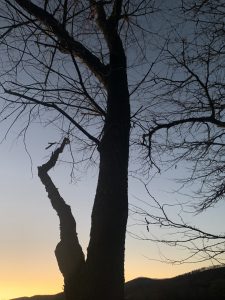 The view of the empty branches in contract with sunset in the background.
The view of the empty branches in contract with sunset in the background.
There were many aspects of my sit-spot that did remain the same, as it continued to provide a safe and comforting atmosphere. The bright green plants were still typically present, as the strong structures of the pine trees remained the same. As the pine cones on the trees matured and fell off, as did the old pine leaves, littering the ground, the sparse pine needles on the leaves allowed for more access of the sunset to pass through the trees. The leaves had slowly fallen off the other trees through the semester, as the mountains and empty lot in front of me (directly West) contained the same access for the sun to set and rise behind. The echoes of the birds, crickets, cicadas, and other organisms seemed to grow louder through the semester as the season had changed, to transform the environment and atmosphere of my sit-spot location. The weather had gotten much colder through the semester, as it had been around 55 degrees for my most recent session compared to the beginning of the semester when it had been in the 80s. The sunset within the sky had contradicted the aspects of the sunset within the beginning of the semester. The sunsets had become much deeper in color, as the warm tones of red and orange changed to deep blues, purples, and pinks. The wind level was definitely present during this session, as the wind had completely surrounded the air, allowing for the sounds of the animals to be overpowered. The differing directions of the wind had also provided for a much colder atmosphere.
My three objects had changed quite a lot throughout the semester. My first object was the lichens and moss along the bark of a tree in my Southwest direction. The lichens and moss had clearly grown more, perhaps with a seasonal change factor, as the bark seemed to be more rigid and worn out. There weren’t any major visible differences present based on the seasonal changes, however. My second object was the small plants with triangular designs, that were scattered all throughout the ground. I was able to take notice throughout the semester that the plants that were once vibrant green and full, had hundreds of insect bites and holes in them. The plants started to develop a brown color on the dark green leaves, and they had large holes in them. My plant in specific, had also had lots of insect-eaten holes in them. Some of the plants remained the same, but a large majority of the plants had been chewed on and eaten. The plants were less dark green and seemed more pale in color due to the seasonal differences. My third object was the small growth of the pine needles on the trees and the pinecones. The pinecone had also started to develop the white, almost frosty layer on it. Its cones were opened more in the outward direction. The bark of Eastern White Pine, like that of many trees, changes as the tree matures. The trees around me are still in the process of fully maturing. When young, the bark is smooth and greenish gray in color. Mature Eastern White Pine trees develop bark with is grayish to reddish-brown, with layers of scales forming ridges that are broken into irregular blocks. The bark on the pine trees look as if you could peel them off by the chunks. It was very interesting to see just how many changed had occurred at my sit-spot after visiting only a couple months later.

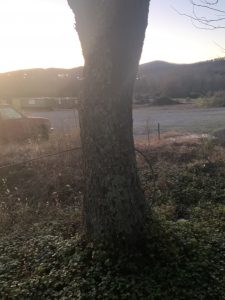
My first object-the My first object- the lichens and moss
lichens and moss on on the tree at the end of the semester.
the tree at the beginning
of the semester.
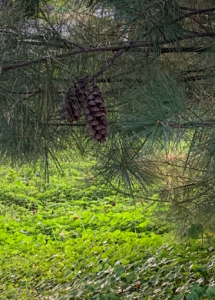
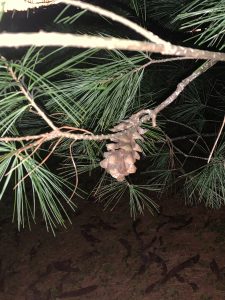
My second object- the pinecones My second object- the pinecones attached
attached to the bottom of the pine tree to the bottom of the pine tree at the end of
at the beginning of the semester. the semester.
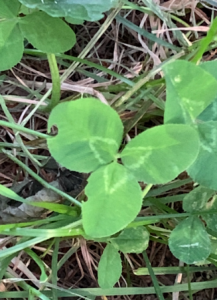
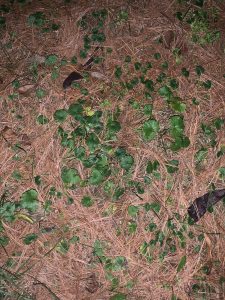
My third object- the small green My third object- the small green insect
insect eaten plants on the ground eaten plants on the ground at the end of
at the beginning of the semester. the semester.
My experiences at my sits-spot sessions had definitely given me the opportunity to be more appreciative and aware of the environment around me. I have completely changed my perspective on being outside in general and for appreciating the true beauty of the environments that I am in. It was absolutely incredible to take note of specific things within my sit-spot, do research on the different sounds and animals/insects I had found, which further led me to value the beauty of nature and its resources. I have deeply enjoyed investigating my sit-spot as ever session was a new part of my journey and adventure in being more conscious and knowledgeable about my surroundings, creating a stronger bond with nature. I was able to learn a lot about myself in addition to the area of my sit-spot, including mentally how I am able to connect and find an inner peace within myself to be completely involved with the opportunity of adventure around me. These sit-spots have made me more comfortable to be out in nature and want to explore more places on campus, and acknowledgement for the life around me.
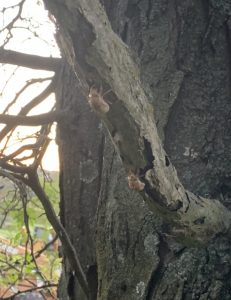 The invasive species of the European chafer beetle.
The invasive species of the European chafer beetle.
Thinking back, the coolest thing that I had experiences at my sit-spot had to have been the invasive species of the European chafer beetle I had found. It was absolutely incredible to watch the beetles so close, and then do deeper research on the insect. I will definitely remember that being very memorable and exciting to investigate, as I was able to connect and recognize more of the specific insects in my sit-spot. I also enjoyed the research I had done in identifying the sounds I heard, to but a sound to name and recognizing the sounds of the animals. There was so much history and adventure still stored in my sit-spot location, that I am thrilled to hopefully continue examining after the course.


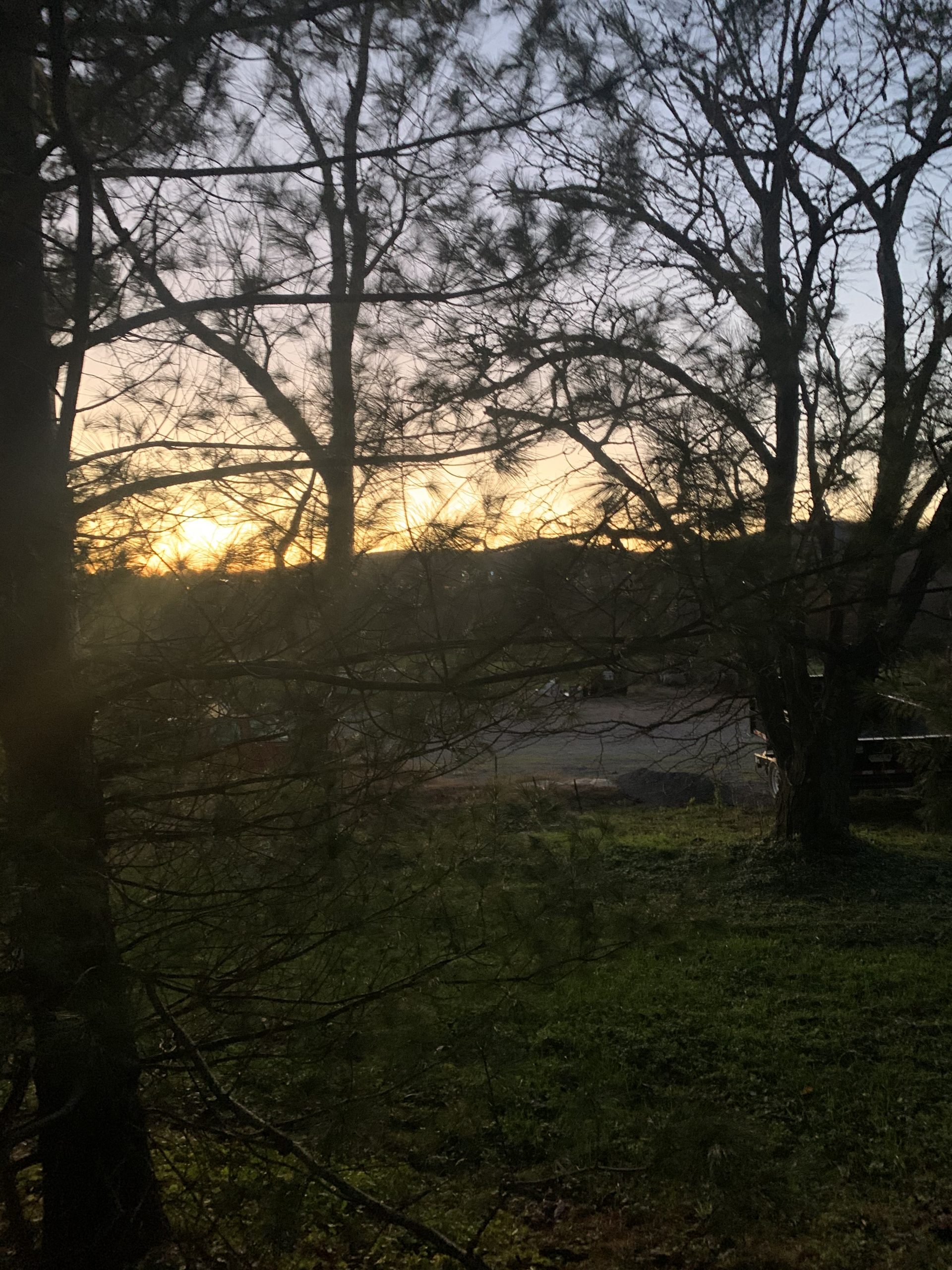
I really loved reading you blog post, and I loved see the photos of you sit spot, it looked really beautiful. I am happy that you did some research on the insects in you area because that must have been nice to understand what you are observing. I also really love your photos especially the photos of the sunrise it was so beautiful and I appreciate your post and you sharing what you have observed.
I love your choice of sit spot! I am envious of you being able to see the sunsets from where you were, they looked so beautiful in your pictures! I also enjoyed reading about the invasive beetles, I had never heard of them or even seen them! That’s awesome that you researched them to getting a better understanding of what they were up too- I might do that now. Nice job 🙂